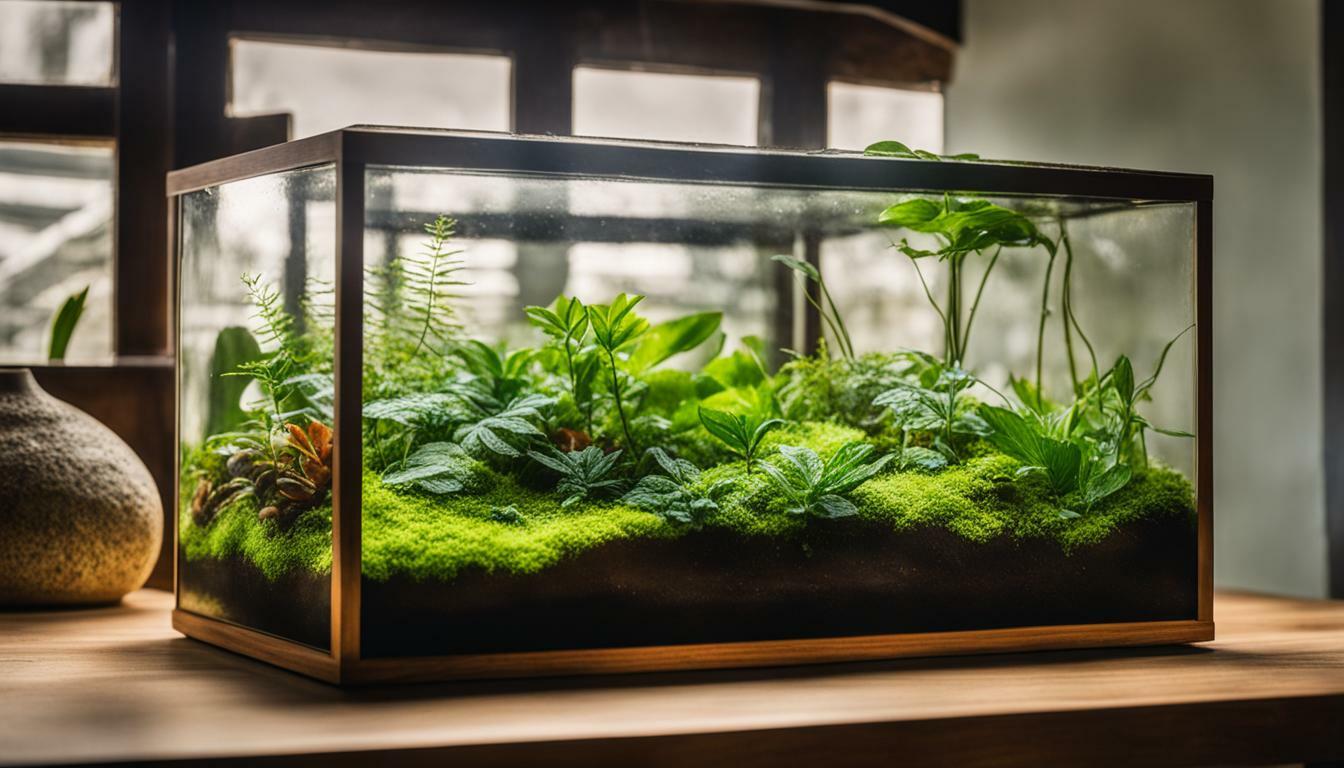Terrarium plants foliage plants are a fantastic way to bring the beauty of nature indoors. Whether you’re a seasoned gardener or a beginner, terrarium gardening offers a unique opportunity to create a lush green paradise right in your own home.
When it comes to growing lush terrarium plants for indoor beauty, there are several options to choose from. For closed terrariums, which create a humid and tropical environment, ferns, foliage plants like peperomia and calathea, vines like selaginella and ficus pumila, epiphytes like air plants, and mosses are ideal choices. These plants thrive in the warm and moist conditions of closed terrariums.
On the other hand, for open terrariums that have better airflow and lower humidity, arid plants such as succulents and cacti work well. Additionally, houseplants like philodendron and spider plants, as well as air plants, can be grown in open terrariums.
The key to growing lush terrarium plants is to choose species that are suited to the specific terrarium environment and conditions, and to provide proper care such as adequate lighting and watering.
Key Takeaways:
- Terrarium plants foliage plants are a fantastic way to bring nature indoors
- Terrarium gardening allows you to create a lush green paradise in your home
- Choose the right plants for closed or open terrariums based on their specific requirements
- Provide proper care such as lighting and watering for healthy plant growth
- Add plant decor and accessories to enhance the overall aesthetic of your terrarium
Now that you know the basics of growing lush terrarium plants, you can start creating your own indoor oasis. With the right plants and care, your terrarium will flourish and bring beauty to your home all year round.
Choosing the Right Plants for Closed Terrariums
When it comes to closed terrariums, it’s crucial to choose plants that can thrive in the warm and moist environment. Here are some low light plants, easy care plants, and houseplants that are perfect for creating a lush terrarium oasis.
1. Ferns: These elegant foliage plants are well-suited for closed terrariums due to their love for humidity and shade. They add a touch of lushness with their feathery fronds, creating a tropical ambiance. Some popular fern varieties for closed terrariums include Boston fern, maidenhair fern, and bird’s nest fern.
2. Peperomia and Calathea: If you’re looking for foliage plants that offer visual interest, peperomia and calathea are excellent choices. Peperomia plants come in various shapes, sizes, and textures, adding a unique touch to your terrarium. Calathea plants, on the other hand, showcase stunning patterns on their leaves, turning your terrarium into a living work of art.
3. Selaginella and Ficus Pumila: Bring a touch of whimsy and cascading beauty to your closed terrarium with vines like selaginella and ficus pumila. Selaginella, also known as spike moss, forms a dense carpet of vivid green foliage, while ficus pumila, commonly known as creeping fig, creates a stunning curtain of lush leaves.
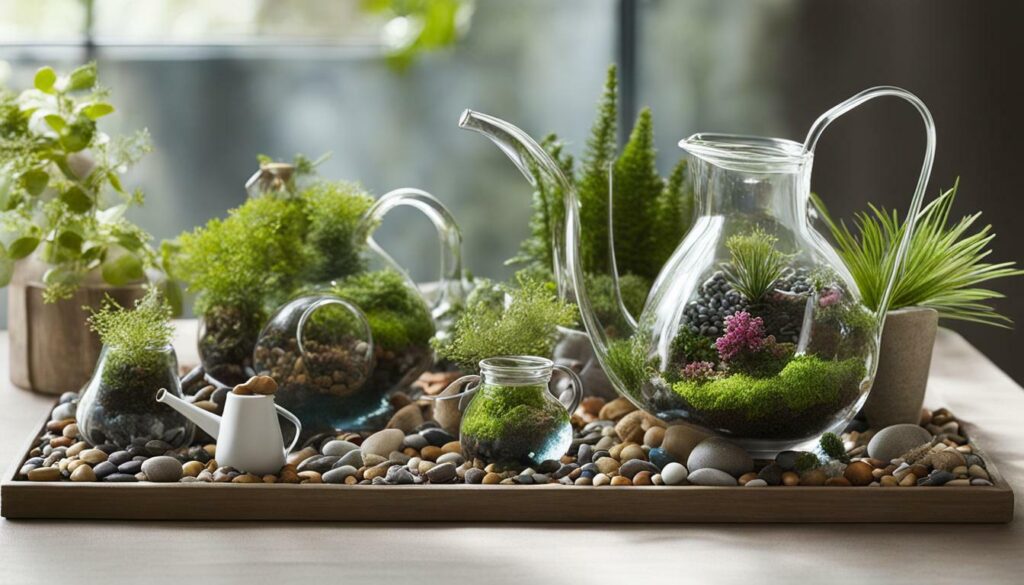
Terrarium Accessories
Complete your closed terrarium with some unique and eye-catching accessories. From miniature figurines to decorative rocks and pebbles, terrarium accessories add a personal touch to your indoor oasis. They provide visual interest and help create a natural-looking environment. Experiment with different elements to create a terrarium that is truly one-of-a-kind.
| Plant | Light Requirement | Care Difficulty |
|---|---|---|
| Ferns | Low to medium light | Easy |
| Peperomia | Low to medium light | Easy |
| Calathea | Low to medium light | Moderate |
| Selaginella | Bright indirect light | Easy |
| Ficus Pumila | Bright indirect light | Easy |
So, whether you prefer vibrant ferns, unique foliage plants, cascading vines, or the ethereal beauty of air plants, there is a wide variety of options to choose from when it comes to selecting plants for closed terrariums. Remember to provide proper care, including adequate lighting and watering, to ensure the long-term health and beauty of your terrarium plants. With the right plants and accessories, your closed terrarium will become a stunning centerpiece in your home, bringing the beauty of nature indoors.
Ferns: Ideal Foliage Plants for Closed Terrariums
Ferns are an excellent choice for closed terrariums, thanks to their love for high humidity and low light conditions. These versatile foliage plants bring a touch of elegance and lushness to indoor spaces, making them a must-have for any terrarium enthusiast.
Featuring a wide variety of leaf shapes, sizes, and textures, ferns can create a beautiful and natural backdrop in a closed terrarium. From delicate fronds to intricate patterns, each fern species adds its unique charm to the overall aesthetic of the terrarium. Some popular fern choices for closed terrariums include the Boston fern, maidenhair fern, and bird’s nest fern.
When it comes to terrarium care, ferns require a bit of attention to thrive. They thrive in moist environments, so regular misting or using a humidity tray is essential to maintain the required humidity levels. Additionally, placing the terrarium in an area with indirect light is ideal for ferns, as they don’t tolerate direct sunlight well.
Overall, ferns are an excellent addition to closed terrariums, offering a touch of natural beauty and a sense of tranquility. These hardy plants thrive in the warm and humid conditions, adding a lush green ambiance to any indoor space.
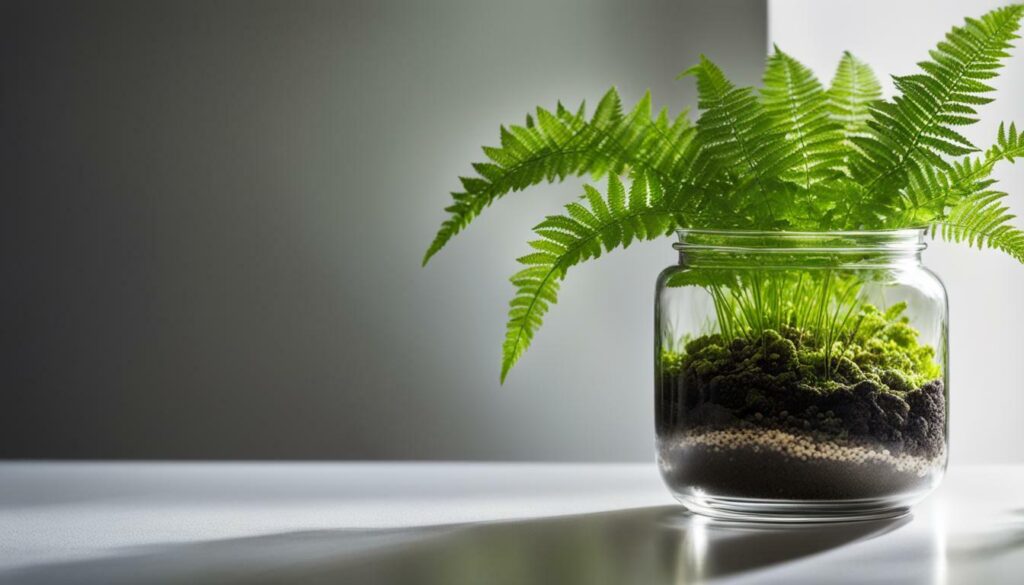
| Fern Species | Light Requirements | Humidity Needs |
|---|---|---|
| Boston Fern | Indirect light to low light | High humidity |
| Maidenhair Fern | Indirect light to low light | High humidity |
| Bird’s Nest Fern | Indirect light to low light | Moderate to high humidity |
“Ferns bring a sense of tranquility and natural beauty to closed terrariums. Their lush foliage and ability to thrive in humid environments make them a perfect choice for indoor gardening enthusiasts.” – Terrarium Gardening Magazine
Foliage Plants: Peperomia and Calathea
If you’re looking to add some impressive foliage to your closed terrarium, peperomia and calathea are two standout options. These foliage plants come in a wide range of leaf shapes, patterns, and colors, adding visual interest to any terrarium display. Their unique characteristics make them popular choices for indoor gardening enthusiasts.
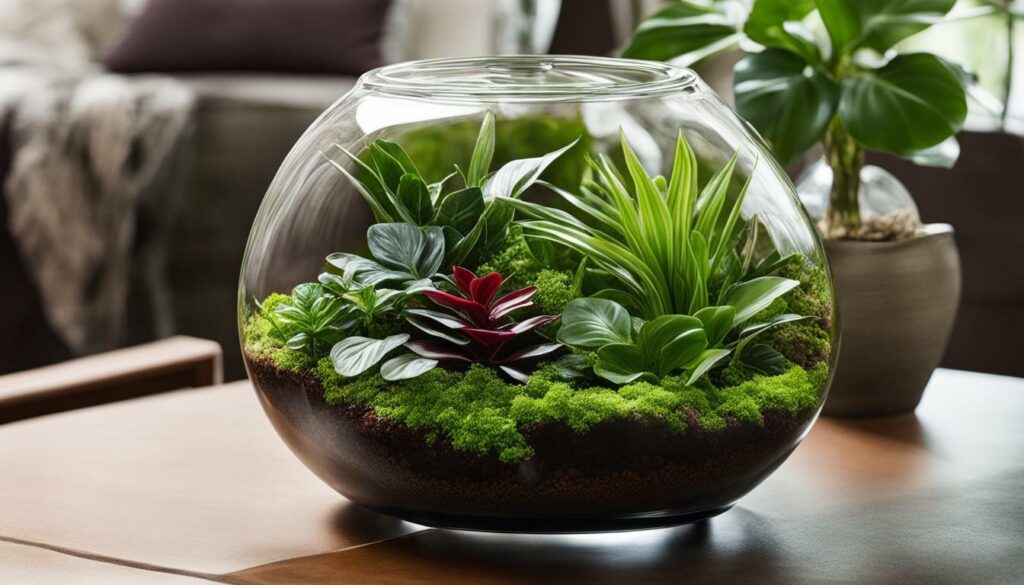
Peperomia is known for its thick, fleshy leaves that come in various shades of green, red, and pink. With their compact size, peperomias are perfect for small terrariums. They are relatively low-maintenance plants, requiring bright, indirect light and moderate watering. Peperomias are also great air purifiers, making them excellent choices for improving indoor air quality.
Calathea, on the other hand, is famous for its striking and vibrant foliage. From the bold patterns of the Calathea ornata to the colorful leaves of the Calathea roseopicta, these plants bring a touch of tropical beauty to any terrarium. Calatheas thrive in well-draining soil and require high humidity levels. They prefer bright, indirect light but should be protected from direct sunlight.
To fully showcase the beauty of peperomia and calathea in your closed terrarium, consider pairing them with other plants that complement their foliage. For example, the cascading vines of selaginella and the delicate fronds of ferns can create a lush and layered terrarium landscape. Adding mosses as a ground cover can also enhance the overall aesthetic of the terrarium.
Table: Comparison of Peperomia and Calathea
| Characteristics | Peperomia | Calathea |
|---|---|---|
| Leaf Shape | Thick, fleshy | Wide, often with patterns and colors |
| Light Requirement | Bright, indirect light | Bright, indirect light (protected from direct sunlight) |
| Watering | Moderate | Regular, keeping soil evenly moist but not waterlogged |
| Humidity | Average | High |
| Size | Compact | Varies |
In conclusion, peperomia and calathea are excellent foliage plant choices for closed terrariums. Their unique leaf characteristics, vibrant colors, and easy care requirements make them popular among indoor gardening enthusiasts. When combined with other complementary plants, such as ferns, vines, and mosses, they create a captivating and visually appealing terrarium display.
Vines: Selaginella and Ficus Pumila
For a trailing and dramatic effect in your closed terrarium, consider incorporating selaginella and ficus pumila. These vines not only add dimension and texture to your terrarium, but they also create a sense of natural beauty and tranquility. Selaginella, commonly known as the spikemoss, features delicate, feathery foliage that forms a lush carpet across your terrarium. Ficus pumila, also known as the creeping fig, has small, heart-shaped leaves that cascade down from the terrarium walls, creating a stunning visual display.
Both selaginella and ficus pumila are well-suited for the warm and humid conditions of closed terrariums. They thrive in the moist environment and require minimal care. These vines are easy to maintain and can tolerate lower light levels, making them perfect for indoor terrariums. Their trailing growth habits add depth and visual interest to your terrarium, turning it into a captivating and enchanting miniature landscape.
To ensure the proper growth of selaginella and ficus pumila, provide them with a well-draining terrarium soil mix that contains a blend of peat moss, perlite, and sand. These plants prefer slightly acidic soil and moderate moisture levels. Avoid overwatering, as it can lead to root rot. Instead, mist the foliage occasionally to maintain humidity. Prune any excess growth to maintain the desired shape and size of your terrarium.
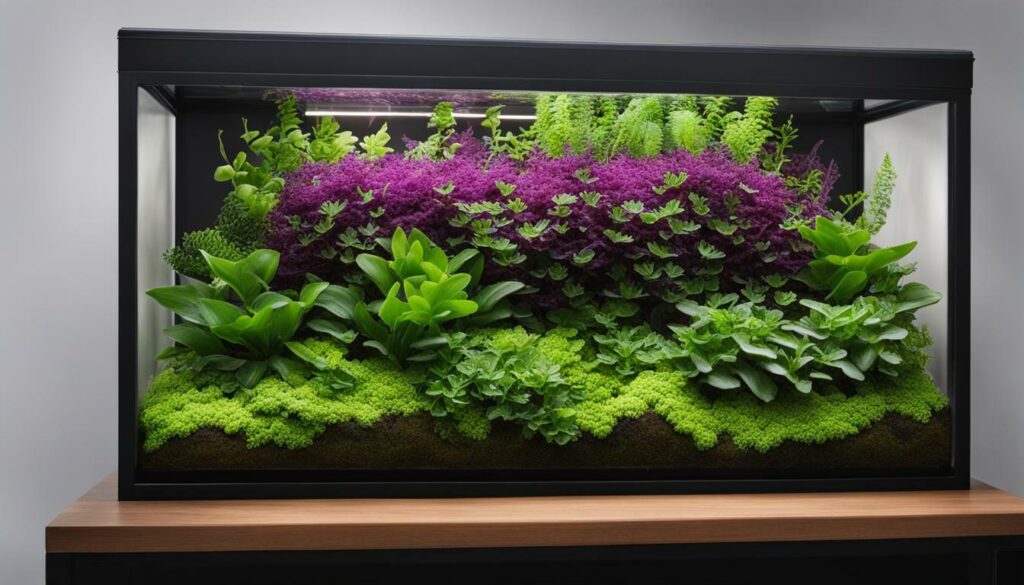
| Selaginella | Ficus Pumila |
|---|---|
| Scientific Name | Scientific Name |
| Selaginella spp. | Ficus pumila |
| Light Requirements | Light Requirements |
| Medium to low light | Medium to low light |
| Watering | Watering |
| Keep soil lightly moist, avoid overwatering | Allow top inch of soil to dry between waterings |
| Growth Habit | Growth Habit |
| Trailing, creeping | Trailing, cascading |
Incorporating selaginella and ficus pumila into your closed terrarium will transform it into a lush and captivating display of greenery. These vines bring life and movement to your terrarium, creating a natural and serene atmosphere. Experiment with different placements and arrangements to find the perfect balance and composition for your terrarium. With proper care and attention, your selaginella and ficus pumila will thrive and become the focal point of your indoor plant collection.
Epiphytes: Air Plants and Mosses
Epiphytes, such as air plants and mosses, are a wonderful addition to closed terrariums. These plants have evolved to grow without soil, making them easy to care for and highly adaptable to the unique terrarium environment. With their ability to absorb moisture and nutrients from the air, they thrive in the warm and humid conditions of closed terrariums.
Air plants, also known as Tillandsias, come in various shapes and sizes, adding intriguing textures and forms to your terrarium. They can be attached to driftwood, stones, or even suspended in the air using wire or string. Their minimal root system allows for creative and decorative arrangements within the terrarium.
“Air plants are the perfect choice for those seeking a low-maintenance terrarium option. They require minimal watering and can tolerate a range of lighting conditions,” says horticulturist Jane Green. “Their unique ability to absorb moisture and nutrients through specialized scales on their leaves makes them ideal for closed terrariums.”
Mosses, on the other hand, provide a lush and verdant carpet-like coverage in closed terrariums. They thrive in the high humidity of the terrarium and can create a serene and forest-like ambiance. There are various types of mosses available, including sheet moss, cushion moss, and mood moss, each offering its own unique texture and visual appeal.
When incorporating air plants and mosses into your closed terrarium, ensure they are positioned in areas with adequate lighting and airflow. Remember to mist the air plants regularly and provide a gentle spritz of water for the mosses to maintain the humidity levels within the terrarium. With their low-maintenance nature and ability to add a touch of natural beauty, air plants and mosses are perfect choices for creating a vibrant and captivating closed terrarium display.
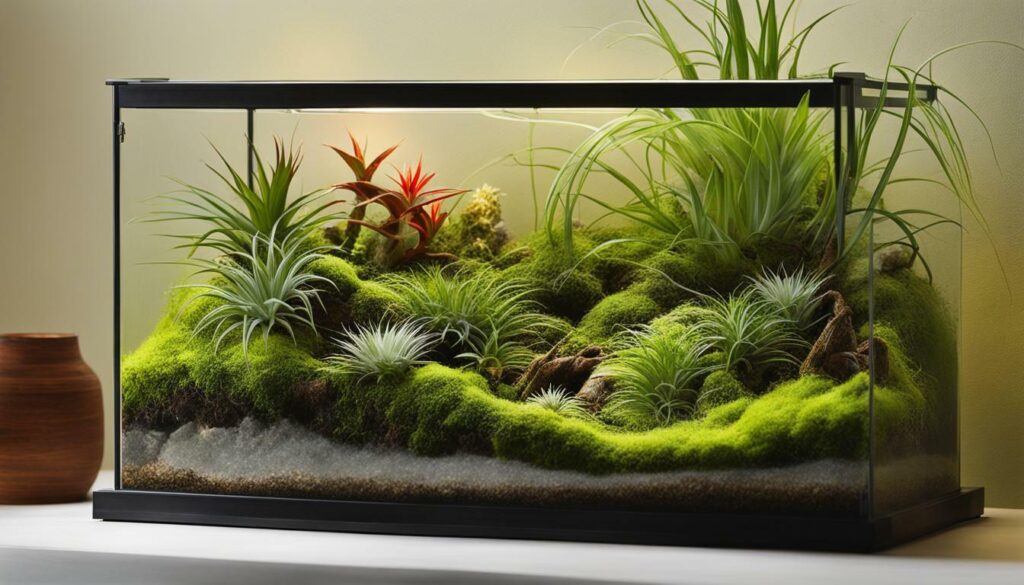
| Characteristics | Air Plants (Tillandsias) | Mosses |
|---|---|---|
| Watering Needs | Regular misting or soaking | Gentle spritzing to maintain humidity |
| Lighting Requirements | Bright, indirect light | Low to moderate light |
| Growth Habit | Epiphytic (no soil required) | Creeping or cushion-like |
| Appearance | Variety of shapes, sizes, and colors | Lush, carpet-like coverage |
Whether you choose air plants or mosses, or both, their inclusion in your closed terrarium will elevate the visual appeal and add an element of natural beauty. As you experiment with different species and arrangements, you’ll discover the joy and tranquility that these unique epiphytes bring to your indoor plant collection.
Arid Plants for Open Terrariums
Open terrariums offer a drier and more aerated environment, making them perfect for arid plants like succulents and cacti. These water-wise plants thrive in low humidity environments and add a touch of desert beauty to any indoor space. With their unique shapes and striking colors, succulents and cacti are not only easy to care for but also make a bold statement in open terrariums.
| Plant | Watering | Light |
|---|---|---|
| Succulents | Water sparingly, allowing the soil to dry completely between waterings. | Place in bright, indirect sunlight. Some varieties can tolerate full sun. |
| Cacti | Water infrequently, allowing the soil to dry out completely between waterings. | Provide bright, indirect sunlight or direct sunlight for a few hours each day. |
When choosing succulents for your open terrarium, consider varieties such as Echeveria, Haworthia, and Sedum. These plants have thick, fleshy leaves that store water, adapting well to dry conditions. Cacti, on the other hand, come in various shapes and sizes, from the tall and columnar forms of the Saguaro cactus to the small and globular shapes of the Ball cactus.
Remember to use a well-draining soil mix specifically formulated for succulents and cacti. This will prevent root rot and ensure the plants receive the proper nutrients. Additionally, providing adequate light is essential for the growth and health of these arid plants. Place your open terrarium in a location that receives bright, indirect sunlight or direct sunlight for a few hours each day, depending on the specific needs of the plants.
By incorporating succulents and cacti into your open terrarium, you can create a stunning display that requires minimal maintenance. These plants thrive in dry environments and can withstand periods of neglect, making them perfect for those with busy lifestyles. Whether you choose a single specimen or create an arrangement with different varieties, the addition of arid plants will bring a touch of nature’s resilience and beauty to your indoor space.
| Benefits of Arid Plants in Open Terrariums | • Adds a touch of desert beauty to indoor spaces | • Requires minimal maintenance and can withstand neglect | • Thrives in low humidity environments |
|---|---|---|---|
| Popular Varieties | • Echeveria: Rosette-shaped succulents in various colors | • Haworthia: Small succulents with intricate patterns | • Sedum: Drought-tolerant plants with fleshy leaves |
| Unique Shapes of Cacti | • Saguaro cactus: Tall and columnar with arms | • Ball cactus: Small and globular | • Moon cactus: Vibrantly colored grafted cacti |
Tips for Growing Arid Plants in Open Terrariums
- Choose succulents and cacti that are well-suited to the light conditions of your space.
- Ensure proper drainage by using a well-draining soil mix in your open terrarium.
- Water sparingly, allowing the soil to dry out completely between waterings.
- Place your open terrarium in a location that receives bright, indirect sunlight or direct sunlight for a few hours each day.
Houseplants for Open Terrariums: Philodendron and Spider Plants
Houseplants like philodendron and spider plants can thrive in open terrariums, thanks to their ability to adapt to different light levels. These versatile plants not only add greenery and freshness to your terrarium but also help improve indoor air quality. Philodendron, with its lush foliage and trailing vines, is a popular choice for open terrariums. It can tolerate low to bright indirect light and requires minimal care, making it perfect for beginners. Spider plants, known for their arching leaves and cascading growth, are another excellent option. They thrive in a wide range of light conditions and are great for purifying the air in your home. Both philodendron and spider plants are low-maintenance and can be easily propagated, allowing you to expand your terrarium collection over time.
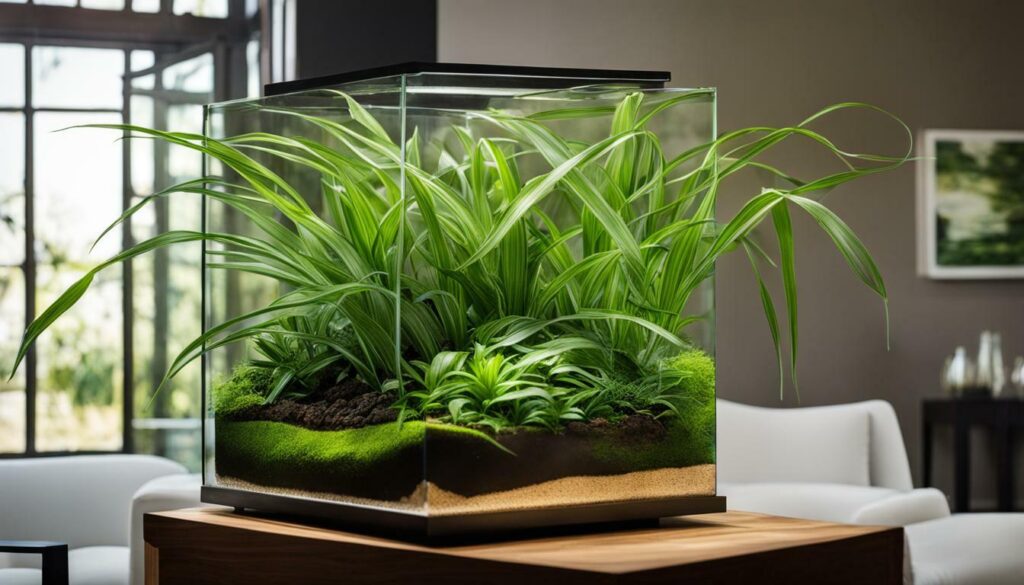
Benefits of Philodendron in an Open Terrarium
- Adaptable to various light levels, making it suitable for different terrarium locations
- Lush foliage adds a touch of tropical beauty to your terrarium
- Vigorous growth and trailing vines create a cascading effect
- Improves indoor air quality by removing toxins
Advantages of Spider Plants in an Open Terrarium
- Tolerates a wide range of light conditions, from bright indirect light to partially shaded areas
- Produces long, arching leaves that complement the terrarium’s vertical space
- Easy-to-care-for plant that requires minimal maintenance
- Acts as a natural air purifier, filtering out harmful pollutants
When planting philodendron and spider plants in an open terrarium, it’s essential to choose a suitable potting mix that provides good drainage. Consider using a mix formulated for houseplants or create your own blend using a combination of peat moss, perlite, and compost. Ensure the terrarium receives adequate airflow and avoid overwatering, as excessive moisture can lead to root rot. With proper care and attention, your open terrarium filled with philodendron and spider plants will bring life and vibrancy to any indoor space.
Proper Care for Lush Terrarium Plants
Growing and maintaining lush terrarium plants requires proper care and attention. From providing adequate lighting to ensuring proper watering, understanding the needs of your indoor plants is key to their overall well-being and stunning appearance. Here are some essential tips to help you care for your terrarium plants.
1. Lighting
Lighting plays a crucial role in the growth and health of terrarium plants. Most indoor plants thrive in bright, indirect light. Place your terrarium in a location where it can receive appropriate light levels, but avoid direct sunlight as it can cause damage to the plants. If you have closed terrariums, monitor the lighting conditions closely to ensure they receive the right amount of light for photosynthesis.
2. Watering
Proper watering is vital for the well-being of your terrarium plants. Different plants have different water requirements, so it’s essential to understand the specific needs of each species. Overwatering can lead to root rot, while underwatering can cause the plants to wither. Check the moisture level of the soil regularly and water accordingly. It’s better to water in small amounts rather than drenching the soil. Consider using a spray bottle to mist the leaves of your terrarium plants, especially for those that prefer higher humidity levels.
3. Humidity and Ventilation
Humidity is an important factor to consider, especially for closed terrariums. The enclosed environment helps create a humid atmosphere, which is beneficial for tropical plants. Monitor the humidity levels inside your terrarium and adjust accordingly by misting the plants or opening the lid to allow for some ventilation. Open terrariums, on the other hand, require lower humidity levels and increased airflow. Ensure proper ventilation by keeping the terrarium’s lid partially open or adding small holes to allow for air circulation.
4. Fertilization
While terrarium plants derive nutrients from the soil and decomposed matter, they may still benefit from occasional fertilization. Use a balanced, water-soluble fertilizer diluted to half its recommended strength. Apply the fertilizer sparingly, following the instructions provided with the product. Overfertilization can lead to nutrient burn and damage the plants. Remember to fertilize your terrarium plants during their active growth period, typically in the spring and summer months.
By following these care tips, you can ensure the health and vitality of your lush terrarium plants. Remember to regularly monitor the lighting, watering, humidity, and ventilation levels, and adjust accordingly to create an optimal environment for your indoor plants. With proper care, your terrarium will flourish and bring beauty to any indoor space.
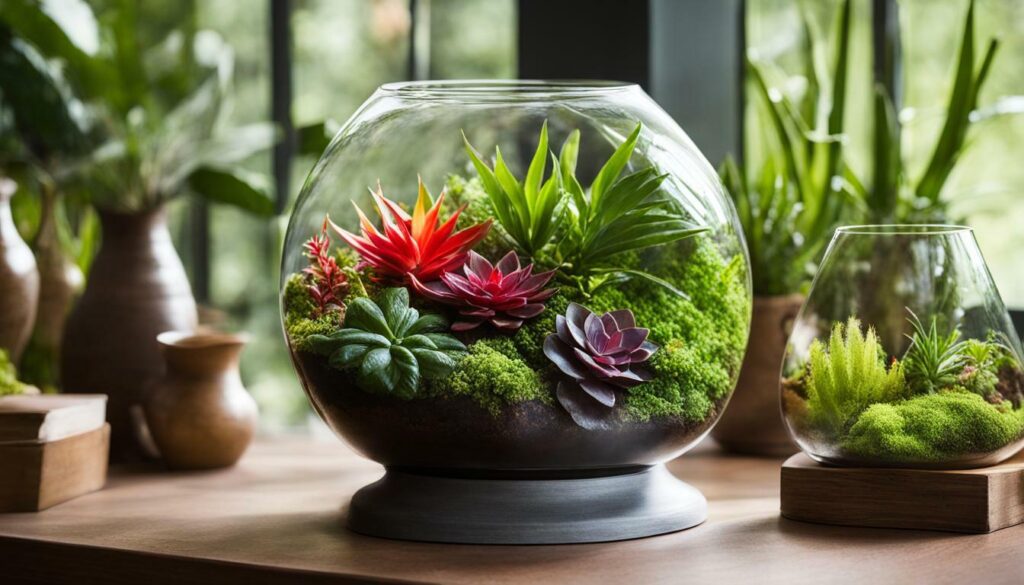
| Plant Care Tips | Lighting | Watering | Humidity | Temperature |
|---|---|---|---|---|
| Ferns | Bright, indirect light | Keep soil consistently moist | High humidity | 65-75°F (18-24°C) |
| Peperomia | Bright, indirect light | Allow soil to dry slightly between waterings | Moderate humidity | 60-75°F (15-24°C) |
| Calathea | Indirect, filtered light | Keep soil evenly moist | High humidity | 65-75°F (18-24°C) |
| Selaginella | Indirect, filtered light | Mist frequently to maintain moisture | High humidity | 60-75°F (15-24°C) |
Conclusion
Terrarium plants, foliage plants, offer a world of beauty and tranquility within the confines of your indoor space. With the right selection of plants, proper care, and thoughtful plant decor, you can transform your terrarium into a lush green haven that brings joy and serenity to your everyday life.
When it comes to growing lush terrarium plants for indoor beauty, there are several options to choose from. For closed terrariums, which create a humid and tropical environment, ferns, foliage plants like peperomia and calathea, vines like selaginella and ficus pumila, epiphytes like air plants, and mosses are ideal choices. These plants thrive in the warm and moist conditions of closed terrariums.
On the other hand, for open terrariums that have better airflow and lower humidity, arid plants such as succulents and cacti work well. Additionally, houseplants like philodendron and spider plants, as well as air plants, can be grown in open terrariums. Overall, the key to growing lush terrarium plants is to choose species that are suited to the specific terrarium environment and conditions, and to provide proper care such as adequate lighting and watering.
Can Creeping Fig be paired with other foliage plants for a stunning terrarium display?
Yes, creeping fig terrarium plants can definitely be paired with other foliage plants to create a stunning terrarium display. The small, delicate leaves of the creeping fig can complement the larger, more robust foliage of other plants, adding depth and texture to the overall arrangement.
FAQ
What are the best plants for closed terrariums?
The best plants for closed terrariums are ferns, foliage plants like peperomia and calathea, vines like selaginella and ficus pumila, epiphytes like air plants, and mosses. These plants thrive in the warm and moist conditions of closed terrariums.
What plants work well in open terrariums?
Arid plants such as succulents and cacti work well in open terrariums, which have better airflow and lower humidity. Additionally, houseplants like philodendron and spider plants, as well as air plants, can be grown in open terrariums.
How do I choose the right plants for my terrarium?
The key to choosing the right plants for your terrarium is to consider the specific terrarium environment and conditions. For closed terrariums, select plants that thrive in warm and moist conditions. For open terrariums, choose plants that can tolerate lower humidity and better airflow.
What care do lush terrarium plants require?
Lush terrarium plants require proper care, including adequate lighting and watering. For closed terrariums, ensure the plants receive indirect light and maintain a consistently moist but not waterlogged environment. For open terrariums, provide bright but indirect light and water sparingly, allowing the soil to dry out between waterings.

